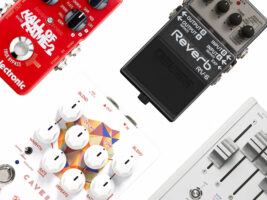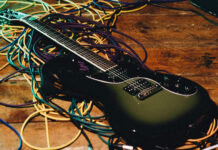
The best reverb pedals to buy in 2023: 14 top options for guitarists
If you’re getting a little bored of your amplifier’s onboard reverb, then we have good news for you. The world of reverb pedals in 2023 is a vast ocean to get lost in: surf the crashing waves of spring reverbs, or dive into an unexplored abyss of out-there ambience. Ready to find the best reverb pedal for you?
READ MORE: The best pedals to buy in 2023: 15 best delay pedals
Why use a reverb pedal instead of amp reverb?
When amplifiers have onboard reverb, it’s most often either a spring reverb tank or a set of digital algorithms. Both of these have limitations: switching the reverb on or off with a footswitch isn’t always possible, and control over the sound is limited to one, maybe two, knobs.
Switching to a reverb pedal opens many more sonic avenues, from recreations of, and improvements on, old-school plate, hall and spring sounds, to wild, characterful and creative effects.
Where in the signal chain do you place the reverb pedal?
So you’re looking at adding one of the best reverb pedals on the market to your rig. But first you need to know where to put it in your signal chain.
Of course, there really are no hard and fast rules in the audio world, so feel free to experiment, but our advice is that the placement of your reverb pedal should depend on the sound of your amplifier. Does it have heaps of headroom, or are you pushing its preamp section into natural overdrive?
If the former, then a reverb pedal should have enough room to breathe when placed between your guitar and your preamp. In the case of the latter, you’ll get the cleanest sound from a reverb pedal when it’s in your effects loop – that is, after your preamp section and before your power amp section. If you don’t have an effects loop and you still want a clean reverb sound from a pedal, consider lowering your preamp gain, making up the difference with a dirt pedal before the reverb.
That’s not to say that ‘clean’ is the only way to do things. Placing a reverb pedal before a distorting preamp section, much like placing one before a distortion, overdrive or fuzz, has its own unique sound, one closely associated with shoegaze and post-rock. It will be by no means clean, but instead you’ll saturate your reverb decays into an enveloping tidal wave of decay.
The best reverb pedals to buy in 2023 at a glance
Gamechanger Audio Light Pedal
Walrus Slötvå
Catalinbread Cloak
Fender Dual Marine Layer Reverb
Strymon Nightsky
Earthquaker Devices Afterneath V3
Walrus Audio Mako R1
Eventide Blackhole
Electro-Harmonix Oceans 12
Earthquaker Devices Astral Destiny
Keeley Caverns Delay Reverb V2
Meris Mercury7
Boss RV-6
Strymon BigSky
Gamechanger Audio Light Pedal
+ True analogue sounds
+ Unique take on a classic format
– Expensive and unwieldy
Real springs are rare in reverb pedals. In fact, there are only two bonafide spring reverbs on this list, and for good reason – spring tanks are large, unwieldy, expensive, and for the sonically adventurous their sound can be a little limiting. Luckily Gamechanger Audio has again lived up to its name and achieved an impressive technical feat.
Traditional spring sounds can be accessed, but thanks to the pedal’s unique sensing methods – optical sensing alongside physical transducer sensing – things can get weird very quickly. There are a number of effects that add a lot of colour to the sound, such as tremolo or harmonic overtones. If you’re looking for a clean ambient reverb, maybe give this one a miss. The nature of the physical, vibrating springs means that decay time is inherently limited, and there’s always going to be some sort of clanging nature to the sound.
Price: £299 / $379
Description: Analogue spring reverb pedal with optical sensing and on-board effects.
Controls: Dry mix, transducer mix, optical sensor mix, tone, effect selector switch, multi-function effect parameter control, drive, noise gate. Toggle switch for latching and trails bypass modes
Bypass: Buffered bypass with optional trails
Mono or stereo: Mono
Read our full review here.
Today’s best deals on the Gamechanger Audio Light Pedal
Check deal at Guitar Center
Walrus Audio Slötvå
+ Beautiful ambient sounds
+ Presets are a useful addition
– Focus on subtle ambience maybe not for everyone
Walrus‘s Slötvå is a minor variation of its classic Slö reverb pedal. It features the same controls and layout as the Slö, with controls for decay, filter, mix and modulation depth, as well as an ‘x’ knob which changes function depending on which of the three sounds you have selected: Dark, Rise or Dream. Each of them offers some excellent soupy ambience to get lost in, with the focus being on pretty yet characterful sounds.
Slötvå’s primary evolution from the Slö, though, is the preset function, which allows you to cycle between three pre-assigned settings to change sounds on the fly. This is extra-handy for those who like to explore the myriad controls in-depth, but don’t want to lose the sounds they spent an afternoon dialling in. The presets are also great for adding some variance into some looping soundscape creation.
Price: $229 / £209
Description: Three-mode digital reverb pedal with extensive controls and presets
Controls: Reverb decay, mix and filter, modulation depth and multi-function ‘X’ knob depending on reverb mode. Mode select switch that, as a secondary function, also selects modulation wave shape. Secondary footswitch
Bypass: True bypass, switchable to buffered bypass with trails
Mono or stereo: Mono
Today’s best deals on the Walrus Audio Slötvå
Check deal at Guitar Center
Check deal at zZounds
Catalinbread Cloak
+ Characterful, intriguing core sound
+ Will make shimmer reverb a lot more bearable to many
– Only two main styles of sound on offer, shimmer and room
Shimmer reverb is a divisive effect. The octave-up sound is to some a perfect ambient effect, invoking a heavenly, ethereal space. To others, it’s an overused cliche – the clean, digital-string-section of toothless ambient rigs.The Cloak, however, makes a good go at satisfying both camps.
As the shrouded figure on its enclosure suggests, the cathedral in which your guitar signal is bounced around is a haunted one rather than a heavenly one. Adding to the darker nature is a high-cut-control, which lets you smooth out the brittle, digital sound that a shimmer reverb into a clean amplifier can create.
Even if you want to forgo the shimmer entirely, the Cloak is an excellent room reverb with a huge range of decay time. But it shines (or, well, shimmers) best when you need a darker twist on an ambient classic.
Price: $209 / £169
Description: Digital room reverb with blendable shimmer effect
Controls: Room size, high cut, wet/dry mix, shimmer blend
Bypass: True bypass, switchable to buffered bypass with trails.
Mono or stereo: Mono
Today’s best deals on the Catalinbread Cloak
Check deal at Guitar Center
Check deal at zZounds
Fender Dual Marine Layer Reverb
+ Modern, up-to-date sounds from a stalwart of reverb effects
+ Channel switching lets you leap between sounds
– Some may want more algorithms for this amount of pedalboard real-estate
Despite being made by a brand most associated with old-school spring sounds, the Dual Marine Layer Reverb offers three reverb modes with no springs, simulated or otherwise, in sight. There are three modes: hall, room and an ambient, shimmer mode. However, the shimmer is a subtle effect that, similarly to the Cloak, shaves off the digital harshness that can come with the territory.
There’s a huge set of controls for each reverb channel, including the useful damping control and the more out-there Mod control. The sustain footswitch also offers something for the drone-inclined, letting you bloom your notes into an infinite blast of decaying noise.
The dual-channel switching nature of the pedal offers presets of a sort, so if you need two drastically different sounds throughout the set then this might be the perfect reverb box for you, just as long as you have the pedalboard space to spare.
Price: $249 / £199
Description: Dual-channel digital reverb pedal with three modes
Controls: Reverb damping, time, modulation and level for each channel, separate knob for sustain level. Separate footswitches for bypass, channel switching and sustain
Bypass: True bypass, switchable to buffered bypass with trails
Mono or stereo: Mono
Read our full review here.
Today’s best deals on the Fender Dual Marine Layer Reverb
Check deal at Guitar Center
Check deal at zZounds
Strymon NightSky
+ Highly tweakable ambient sounds
+ Full MIDI support
– Expensive
It’s safe to say that if a pedal calls itself ‘a reverberant synthesis workstation and hands-on experimental sound design platform’, then you’re in for some massive, stereo ambience that evokes the hugeness of, well, the night sky.
This big blue box from Strymon is loaded with three core reverb textures, each of which can all be modulated with tape-esque pitch wobbles, reverberant LFO sounds or wah-like filter sweeps to the tune of five different waveforms, or an envelope that follows your playing dynamics.
A pitch-shifted shimmer voice can either add ethereal sparkle or an intimidating rumble. In fact, the shimmer section has a full selection of intervals to choose from, meaning you can shift your trails up or down by a second, fourth, fifth or octave.
Notably, there are separate controls for the wet and dry signals, and the ability to morph between two completely different sounds via an expression pedal. MIDI support also opens up 300 presets in total, or alternatively eight accessible via illuminated buttons on the pedal’s face.
Price: $429 / £439
Description: Multi-function ambient delay with recallable presets and a variety of modulation modes
Controls: Modulation speed, type, depth, waveform shape, low-pass and high-pass filters, pitch-shift interval, shimmer mix, reverb mix, dry mix,
Bypass: True bypass
Mono or stereo: Stereo
Read our full review here.
Today’s best deals on the Strymon BigSky
Check deal at Guitar Center
EarthQuaker Devices Afterneath V3
+ Unique core sound
+ Flexible expression/CV support
– Traditional reverb sounds are hard to conjure
The latest version of EQD’s Afterneath uses a tried and tested digital reverb algorithm that’s chock full of ethereal spaciness and pitch-shifting oddness – but with a few extra additions.
The pedal’s big selling point is the interaction between the Mode control and the Drag control, with the former adjusting the latter’s behaviour. The Drag control, now adjustable via an expression pedal, sweeps your reverb trail up through a certain set of pitches. The Mode control introduces varying amounts of quantisation, meaning you can have completely smooth drifting all over the place, or some arpeggiation locked to a certain scale.
It’s no ordinary reverb sound, but a healthy amount of controls means you can tame things before your pitch-shifted trails completely eclipse your playing. And if that’s precisely what you want, there’s a good chance you’ve already put the Afterneath V3 in a cart by this point.
Price: $199 / £199
Description: Pitch-drifting reverb made of cascading delays with support for expression and CV control over pitch Controls: Length, diffuse, dampen, reflect, drag (pitch drift), mix
Bypass: True bypass
Mono or stereo: Mono
Read our full review here.
Today’s best deals on the EarthQuaker Devices Afterneath V3
Check deal at Guitar Center
Check deal at zZounds
Walrus Audio Mako R1
+ Massive range of sounds
+ Compact compared to some digital reverb workstation
– Not what-you-see-is-what-you-get
Walrus Audio‘s Mako series is something of a Goldilocks pedal. While this stereo reverb stompbox has all the trendy high-end bells and whistles – stereo support, huge present banks and powerful signal processing – it’s quite compact and rather fetching in its stepped enclosure. It even packs in a tap-tempo footswitch. Not bad for a pedal that measures less than 8cm across.
READ MORE: Colt Westbrook on Walrus Audio’s game-changing new Mako Series
At its core are six reverb sounds: three traditional, three less so. The spring, hall and plate reverb all offer hi-fi recreations of the classic types. The other three ( BFR, Refract and Air) are all better suited for soundscapes.
Also handy for soundscape purposes: delay time that can extend effectively forever (or, literally forever, if you use the infinite press-and-hold footswitch), extensive modulation options, and how you can hide your note’s attack with the swell control.
Price: $349 /£319
Description: Digital multi-mode stereo reverb pedal with presets
Controls: Decay, swell, dry/reverb mix, modulation rate/depth/pre-delay switch with tweak knob, EQ low/high/X switch with tune knob, preset bank A/B/C switch, six-way rotary programme switch; bypass and sustain/latch footswitches
Bypass: True Bypass
Mono or stereo: Stereo
Read our full review here.
Today’s best deals on the Walrus Audio Mako R1
Check deal at Guitar Center
Check deal at zZounds
Eventide Blackhole
+ Can be the start of a stereo signal chain
+ Wide range of ambient tones
A standalone version of the Blackhole algorithm found on Eventide’s famed H9 and H9000 multi-effects processors, this pedal’s name should give you an indication of spatial tones it offers up.
Its voice is unapologetically modern, but that’s not to say it can’t do the more ‘vintage’ sounds. The Size knob, at lower settings, will happily give you some room reverb tones that almost resemble slapback delay sounds. But when increased beyond the nine-o-clock mark, things start to get big, with sprawling trails that evoke the pedal’s namesake.
A reverb sound that massive can quickly become unwieldy; lucky you have a few tools at your disposal to keep your signal tidy. Firstly, there’s Gravity, which adjusts the attack of the reverb sound, meaning it can attack with immediacy or bloom in behind your playing. To keep your dry and wet signals more separate, you’ve also got high- and low-pass filters, as well as the option to adjust these filters’ resonance for even more experimentation.
Speaking of experimentation, the Mix knob allows you to completely kill your dry signal – allowing for completely transformative, cello-like sounds and even more abstract soundscaping.
The pedal’s also firmly in the ‘workstation’ category, with five onboard presets, and 127 accessible via MIDI. An expression pedal can also blend between heel and toe presets for smooth transitions, or just some inspiring, unexpected sounds.
Price: $249/£279
Description: Standalone version of Eventide’s Blackhole reverb algorithm
Controls: Mix, Gravity, Feedback, Reverb Size, low- and high-pass filter, freeze footswitch, preset recall function, secondary deep editing
Bypass: True bypass
Mono or stereo: Mono input, stereo output
Today’s best deals on the Eventide Blackhole
Check deal at Guitar Center
Check deal at zZounds
Electro-Harmonix Oceans 12
+ Extensive controls and I/O
+ Affordable way to access a huge number of sounds
– Could cause option paralysis
The EHX Oceans 12 adds a few extra controls and features to its predecessor, the Oceans 11, which is already an absurdly feature-packed little pedal. It’s a “dual stereo reverb”, meaning that housed within its bigger enclosure are two reverb engines – both are completely stereo and can be run in series or parallel.
The Oceans 12 also has stereo inputs and outputs, so it should slot happily anywhere into an existing stereo rig. It can, of course, function fine in mono, too. There’s even an effects loop to add in more effects to the mix.
The biggest appeal of the Oceans 12 is the sheer number of options available. There are 12 core reverb sounds – most of which have two modes, some three – and then there are two reverb engines at work. The tones themselves range from drippy spring reverbs to shoegaze-friendly reverse reverbs to huge shimmering ambience. If you’re indecisive about the reverb tone you need at your feet, then the Oceans 12 keeps your options open.
Price: $269/£229
Description: Stereo reverb pedal with 12 core sounds and two independent sound engines
Controls: Effect level, pre-delay, decay time and tone knobs, reverb type selector, two controls specific to each type, switchable trails, mode selector switch
Bypass: Buffered bypass
Mono or stereo: Stereo
Today’s best deals on the Electro-Harmonix Oceans 12
Check deal at Guitar Center
Check deal at zZounds
EarthQuaker Devices Astral Destiny
+ Multitude of takes on the shimmer concept
+ Stretch footswitch and expression pedal let you get weird
– Not for those who don’t like octave reverbs
This reverb is based around the shimmer sound – that is, when reverb trails are shifted an octave up or down. Per EQD fashion, however, there’s some weirder stuff at play here with several modes for a variety of reverb voices as well as in-built chorus modulation. The voices range from standard octave up or down shimmers, to stranger things such as the Astral mode, which cascades your pitch-shifted trails into themselves for blooming, chaotic ambience.
It’s versatile enough as a ‘set-and-forget’ sound to add some pitch-shifted ambience to your sound. But with the momentary Stretch footswitch, you can suddenly double the decay time of the reverb and thus warp the pitch of your repeats, an effect that’s highly interactive depending on the mode you’re in.
An expression pedal can also be mapped to either length, tone, mix or modulation depth or rate for even more interactivity.
The Astral Destiny’s focus on one style of reverb is both a pro and a con – while it might not cover the same reverb ground as a multi-reverb stompbox (no old-school spring sounds here), it dives deep into its sound niche and discovers some exciting, cosmic sounds.
Price: $199/£205
Description: Shimmer reverb with presets, modulation, and variety of pitch-shift modes and analogue dry-signal path
Controls: Preset and mode selector knobs, depth, rate, tone, mix and length knobs, stretch footswitch
Bypass: True bypass
Mono or stereo: Mono
Read our full review here.
Today’s best deals on the EarthQuaker Devices Astral Destiny
Check deal at Guitar Center
Check deal at zZounds
Keeley Caverns Delay Reverb V2
+ Both delay and reverb have fantastic core sounds
+ Versatile modulation options from both
– The delay is focused on analogue tape-echo rather than massive digital ambient sounds
Delay and reverb are a great combo, and so it’s no surprise that Keeley’s Caverns, which combines them both into one versatile stompbox, has become one of the brand’s most celebrated pedals.
READ MORE: Robert Keeley on his career switch from engineering professor to star pedal maker
The delay side of things offers a modulated tape echo style, although the modulation is totally optional and quite tweakable. There’s a rate knob for the speed of the modulation, and a toggle switch to choose between two different depths – or turning it off entirely. There are also controls for time, mix and repeats, with the latter being able to push the pedal into self-oscillating bliss.
The reverb side also has a toggle switch for choosing between a modulated reverb sound, spring reverb or shimmer. Handily, the modulation is appropriate to each style. The old-school spring reverb sound offers a suitable Fender black-panel-style tremolo, the modulated reverb offers adjustable chorus ambience, and the shimmer style lets you tweak how ‘fed-back’ its octave-up voice is.
The reverb side also has a dedicated warmth knob to keep the wet signal from stomping all over your playing. Both sides of the pedal can be activated independently, with their respective blend knobs keeping things balanced. If you want something slightly more out there, but don’t want to lose traditional sounds – in both the worlds of delay and reverb – the Caverns is a great choice.
Price: $199/£199
Description: Dual delay and reverb pedal with independent switching
Controls: Reverb type, blend, warmth, modulation rate and decay time, Delay blend, time, modulation rate, repeats, and modulation amount.
Bypass: Switchable true-bypass or trails
Mono or stereo: Mono
Today’s best deals on the Keeley Caverns Delay Reverb V2
Check deal at Guitar Center
Check deal at zZounds
Meris Mercury7
+ Offers two great but different styles of massive reverb
+ Hidden features are a nice bonus
– Not too many options for “traditional” reverb sounds
The Mercury7 has a space-related name, so it’s no surprise that it’s offering up some galactic-sized ambience. In this case, the reverb space comes in two flavours: Ultraplate and Cathedra. The former has a fast attack but a more understated size and frequency character. That means it still sits as a lush, spongy layer beneath your tone.
Cathedra, on the other hand, has a much more present ‘architectural’ character, rather than Ultraplate’s abstract one. It’s got a slower attack to reflect the size of an actual space. And for further tweaking and balancing there’s a set of low- and high-pass filters.
Pitch-shifting can be applied to the trails, ranging from sub-octave to shimmer sounds, as well as slow drifting up or down. There’s a separate LFO-operated modulation onboard for more wobble, as well as a host of hidden features accessible via the alt-footswitch. The latter also doubles up as a way to suddenly max out decay time, or to engage auto-swell mode for hiding your note’s attack.
It’s perhaps refreshing to see this much power and tweakability applied to a pared-down selection of two core voices. If pedals like the Oceans 12 give you option paralysis, but you’re looking for something more outre than a spring-reverb-in-a-box, the Mercury7 strikes a great balance.
Price: $299/£299
Description: Digital reverb with two modulated and pitch-shifted voices
Controls: Space decay, modulation, reverb mix, low- and high-pass filters, pitch-shift mode selector, swell footswitch
Bypass: True bypass
Mono or stereo: Mono input, stereo output
Read our full review here.
Today’s best deals on the Meris Mercury7
Check deal at Guitar Center
Boss RV-6
+ Both ambient and traditional bases covered
+ Versatile I/O and analogue-dry-through
– Not too much deep editing on offer
Fitting into Boss’ famed compact form factor, the RV-6 offers a huge number of features for its size and price. Similar to the Oceans 12, it’s packed with a huge range of core sounds, from spring and plate emulation to modulated and shimmer reverbs. These sounds can be tweaked via level and tone controls, which is great if you just want a variety of sounds straight out of the box.
The RV-6 should also pique the interest of wet-dry-rig enthusiasts for two reasons. Firstly, the pedal remains completely analogue dry-through, so no phase issues should arise if you’re using two amps. And secondly, by using just the ‘B’ input, the pedal outputs a 100 per cent wet signal, meaning it can slot happily into more complicated rigs.
Price: $169/£149
Description: Stereo reverb with mode switch for 10 algorithms in total
Controls: Reverb mode selector switch, time, mix and tone knobs
Bypass: Buffered bypass
Mono or stereo: Stereo
Read our full review here.
Today’s best deals on the Boss RV-6
Check deal at Guitar Center
Check deal at zZounds
Strymon BigSky
+ Achingly beautiful ambient tones
+ Stereo is used well to create massive space
– Expensive
The BigSky is another reverb pedal staple, and for good reason. It offers 12 reverb types, with the stalwart spring, plate and hall sound well catered for. Where it’s found the most favour, however, is in its proprietary ambient sounds, such as Bloom, Chorale and, especially, Cloud.
These extremely tweakable sounds are fine-tuned for enormous ambience, creating synthesiser-pad-like drones and airy highs that make full use of the pedal’s stereo support.
With the number of MIDI presets and depth of controls, it’s certainly a reverb for those serious about their sound. It’s the reverb nerd’s reverb pedal, one which you might find yourself lost in. The price tag certainly reflects this, but given how ubiquitous it is across pedalboards everywhere, the Strymon BigSky has certainly earned its reputation.
Price: $479/£449
Description: Stereo reverb with preset support and 12 reverb voices
Controls: Decay, pre delay, mix, tone and modulation knobs as well as two parameters that depend on the current reverb voice
Bypass: True bypass
Mono or stereo: Stereo
Today’s best deals on the Strymon BigSky
Check deal at Guitar Center
Check deal at zZounds
The post The best reverb pedals to buy in 2023: 14 top options for guitarists appeared first on Guitar.com | All Things Guitar.
Source: www.guitar-bass.net











